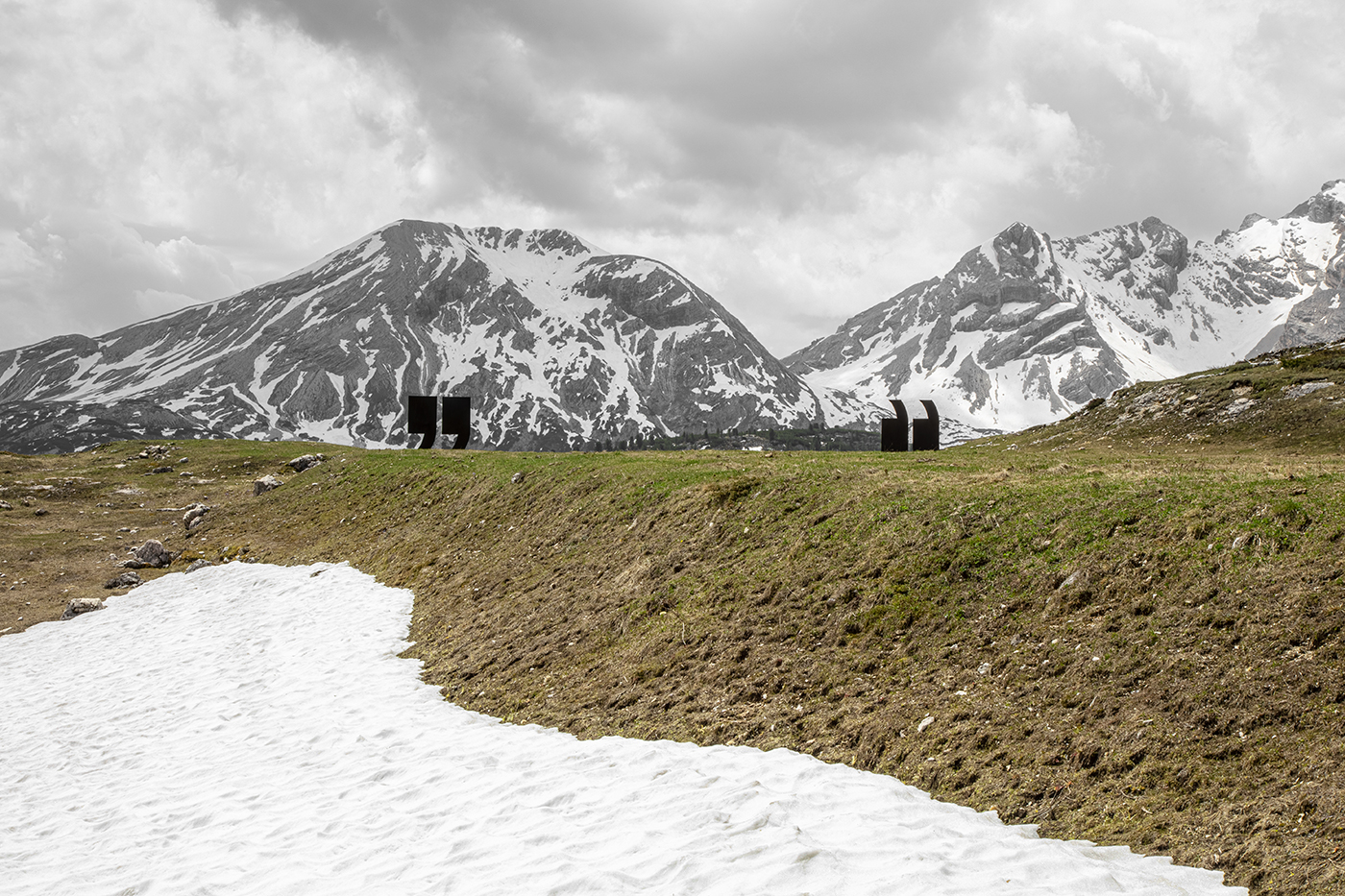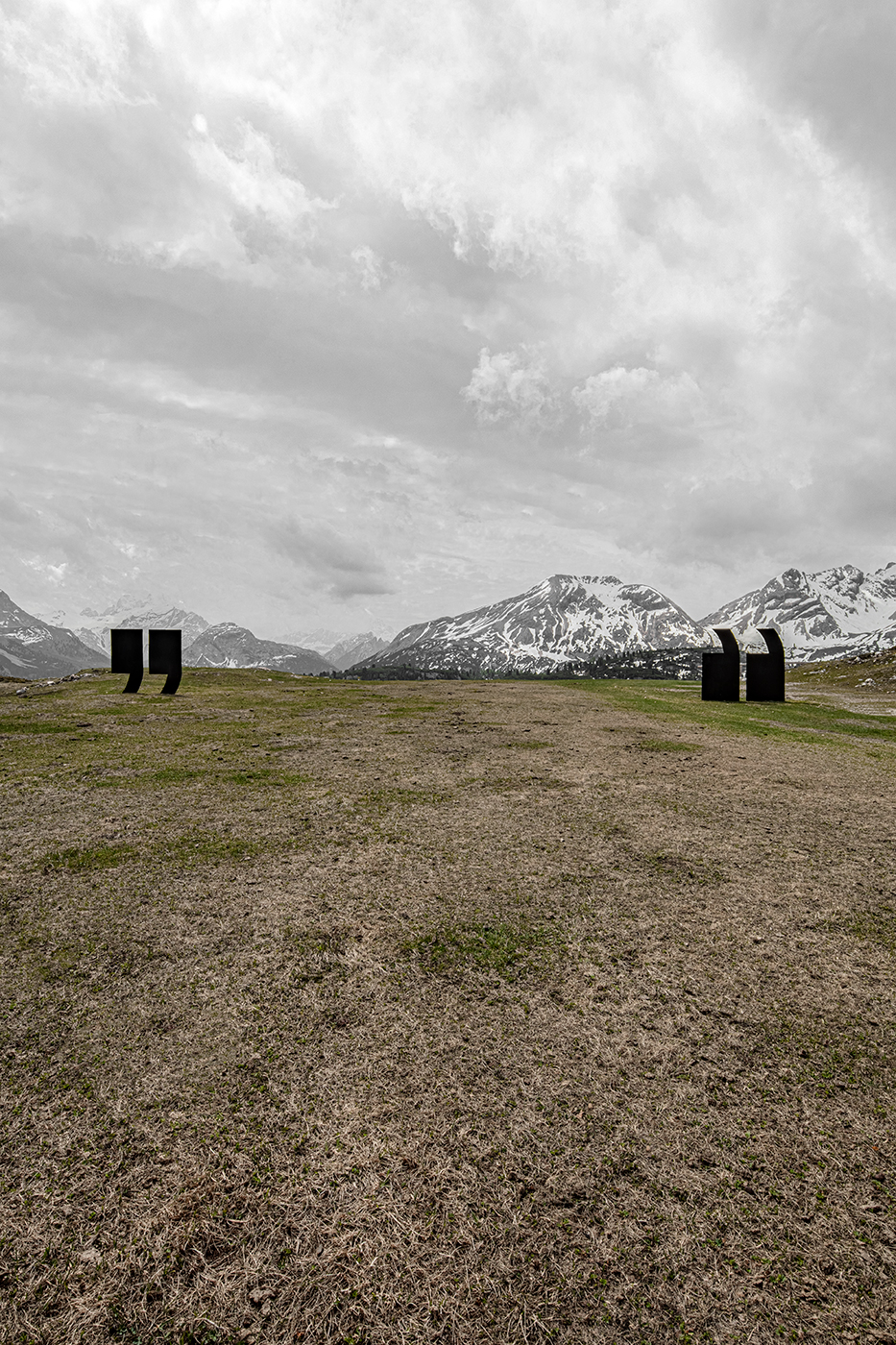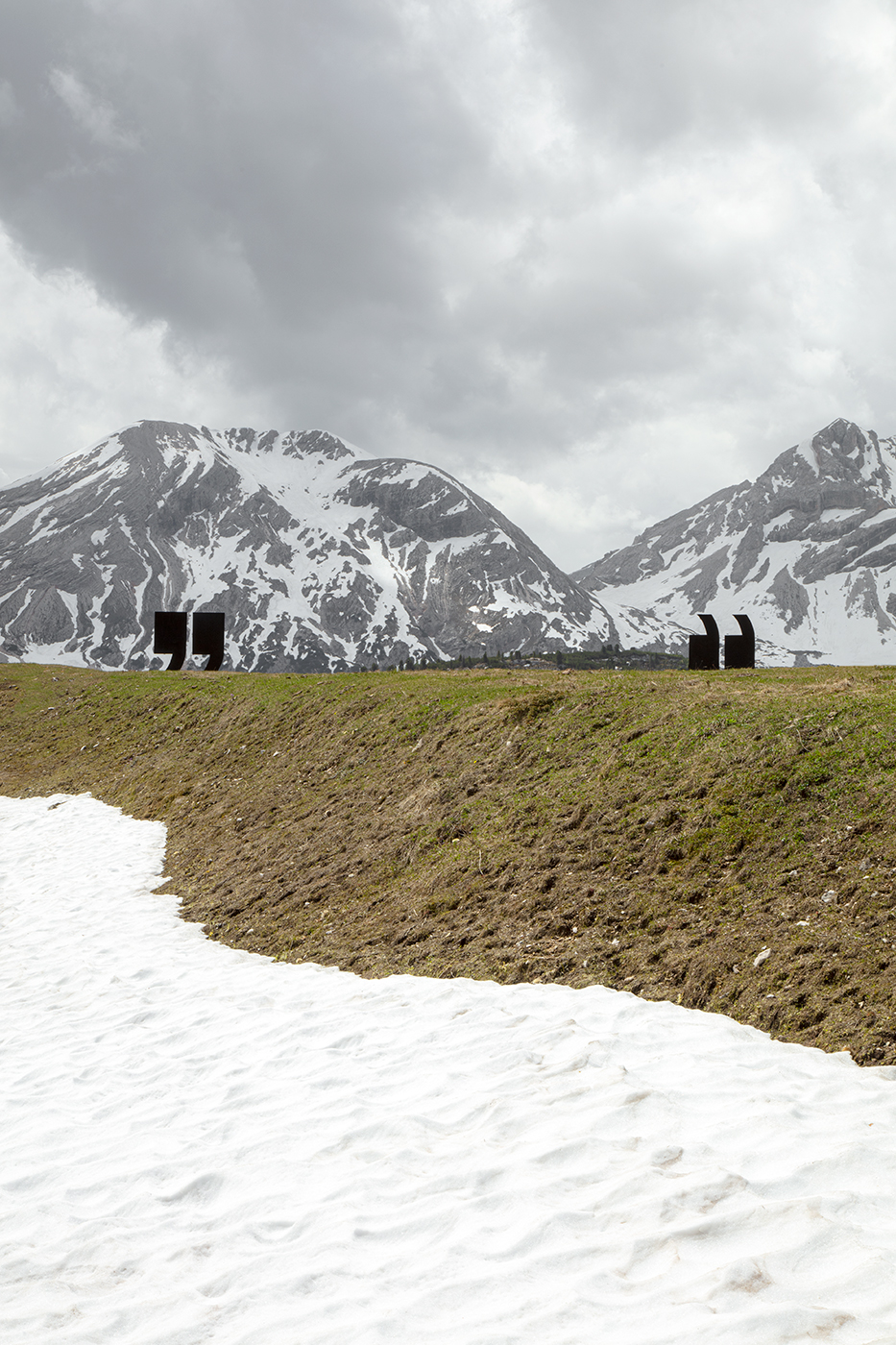NAZAR BILYK, “QUOTES”.
Kyiv, Ukraine.
Location Senes, Mareo.
Two quotation marks in pairs are a simple and universal typographical sign, usually used in writing to indicate quotations themselves, or to indicate that some words are to be understood with particular nuances of meaning. Positioning them in a frame of an idyllic alpine landscape, with a homely farmhouse in the Senes alpine pasture as focal point, the artist invites us to reflect on the concept of Heimat: in a time when many traditional attributes lose the meanings shared in the past, things are reduced to a more strictly subjective sensation and therefore to an illusory and changing interpretation.
In this moment of great transformation of anthropic landscapes there are places however that do not change, that seem to be quotations from a remote past, frozen and motionless - sacred, we could say. And the confrontation with the present provokes restless questions. Does identity still form through the place of residence when mobility is dizzyingly fast? And is experience formed by the environment if personal relationships are to be considered inferior to virtual ones
〉 Ladin
Le per de virgolëtes é n sëgn tipografich scëmpl y universal, adoré canche an scrí por segnalé zitaziuns, o por segnalé che cer parores á n significat particolar. Les posizionan sciöche cornisc de n paesaje alpin idiliach cun na ütia, sön Senes, nes inviëia l’artist da ponsé do sön le conzet de Heimat: te n tëmp olache tröc de sü atribuc tradizionai perd le significat che ai â tl passé, devënta Heimat na sensaziun plü sogetiva, na costruziun che nasc da na ilujiun y che se müda.
Te chësc momënt de de gran trasformaziuns ti paesaji antropics él posć che ne müda nia, che pé zitaziuns de n tëmp dalunc tl passé, dlaciá ite y chic – sacri podesson dí. Y le confrunt cun le presënt fej gní sö domandes che ne lascia nia pesc. Se forma l‘identité tres ciamó tl post de residënza, sce la mobilité vá talmënter debota? Y vëgn l’esperiënza formada dal post, sce i raporc personai vëgn aratá da manco co chi virtuai?
〉 Italiano
Due virgolette in coppia sono un segno tipografico semplice e universale, usate solitamente in scrittura per indicare citazioni, oppure per segnalare che alcune parole sono da intendere con particolari sfumature di significato. Posizionandole a cornice di un idillico paesaggio alpino, con tanto di casolare della malga di Senes, l'artista invita a riflettere attorno al concetto di Heimat: in un tempo in cui molti dei suoi attributi tradizionali perdono i significati condivisi nel passato, essa si riduce a una sensazione più strettamente soggettiva e quindi a costrutto illusorio e cangiante.
In questo momento di grande trasformazione dei paesaggi antropici ci sono luoghi che non cambiano, che sembrano citazioni da un passato remoto, congelati e immobili - sacri, potremmo dire. E il confronto con il presente stana domande irrequiete. L’identità si forma ancora attraverso il luogo di residenza quando la mobilità è vertiginosamente veloce? E l’esperienza è formata dall’ambiente se i rapporti personali sono ritenuti inferiori a quelli virtuali?
〉 Deutsch
Anführungsstriche sind ein einfaches und universelles typografisches Zeichenpaar, das üblicherweise in der Schriftsprache verwendet wird, um Zitate zu kennzeichnen oder um anzudeuten, dass gewisse Wörter mit besonderen Bedeutungsnuancen zu verstehen sind.
Indem er durch Gänsefüßchen eine idyllische Berglandschaft mit einer Hütte auf der Seneser Alm einrahmt, fordert der Künstler zum Nachdenken über das Konzept Heimat auf: In einer Zeit, in der viele ihrer traditionellen Attribute, die noch vor kurzem allgemein geteilten Bedeutungen verlieren, wird Heimat auf eine eher subjektive Empfindung und damit auf ein illusorisches und irisierendes Konstrukt reduziert.
In diesem Moment der großen Umwälzungen der anthropischen Landschaften gibt es Orte, die sich nicht verändern, die wie Zitate aus einer fernen Vergangenheit eingefroren und regungslos, man könnte sagen, heilig scheinen. Und die Konfrontation mit der Gegenwart wirft beunruhigende Fragen auf. Bildet sich durch den Wohnort noch Identität, wenn Mobilität heute schwindelerregend schnell ist? Und ist die Erfahrung noch durch das Umfeld geprägt, wenn persönliche Beziehungen im Vergleich zu den virtuellen als minder wichtig angesehen werden?
EXHIBIT SPACE
Sennes - The Senes plateau is located in the northern Dolomites and is part of the Fanes-Senes-Braies nature park. Since 2009, it has been a UNESCO World Heritage Site. At the foot of the surrounding mountains (among others, Monte Sella di Sennes, Croda del Becco and to the east Croda Rossa) extends a “malga” (farm) which still operates during the summer months.
〉 Ladin
Senes - L’altöra de Senes é da ciafé tla pert nord dles Dolomites y fej pert dl Parch natural Fanes-Senes-Braies y dal 2009 incá dl Patrimone Mondial dl’UNESCO. La munt che vëgn dötaurela manajada tratan i mëisc da d’isté, se sleria fora a pe di crëps incëria pro chi ch’al alda Muntejela de Senes, Sas dla Porta y Crëp Alt dala pert cuntra ost.
〉 Italiano
Sennes - L’altopiano del Senes è situato nelle Dolomiti settentrionali, fa parte del parco naturale Fanes - Senes -Braies e dal 2009 è Patrimonio Mondiale UNESCO. Alle pendici dei monti che lo circondano (tra le altre, Monte Sella di Sennes, Croda del Becco e verso oriente la Croda Rossa) si estende una malga tuttora gestita durante i mesi estivi.
〉 Detusch
Sennes - Die Hochebene von Senes liegt in den nördlichen Dolomiten, ist Teil des Naturparks Fanes-Senes-Braies und zählt seit 2009 zum Weltkulturerbe der UNESCO. Auf den umliegenden Berghängen (unter anderem der Monte Sella di Sennes, der Seekofel und im Osten die Rotwand) erstreckt sich eine in den Sommermonaten bewirtschaftete Almwiese.



